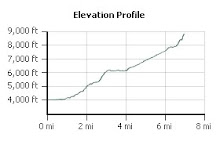 In February when Christina and I signed up for Team in Training's Half Dome hike, my immediate concerns were leaving our young son with others on many Saturdays, and asking lots of people for money, and possibly re-activating old injuries. I injured my knees eleven years ago in high-impact aerobics and roller-coaster waiting lines and it took over a year to heal itself. I was quite leery of putting our bodies at high risk for permanent damage, for this entirely optional adventure. We choose to go for the dream, anyhow.
In February when Christina and I signed up for Team in Training's Half Dome hike, my immediate concerns were leaving our young son with others on many Saturdays, and asking lots of people for money, and possibly re-activating old injuries. I injured my knees eleven years ago in high-impact aerobics and roller-coaster waiting lines and it took over a year to heal itself. I was quite leery of putting our bodies at high risk for permanent damage, for this entirely optional adventure. We choose to go for the dream, anyhow.So I've been half expecting my knee problems to return during our training hikes. Hiking poles helped a lot on the downhills. My knees seemed okay even on our steepest, hardest hike, to Mission Peak above Fremont twice in the same day. My bigger problems that day was getting out of breath and energy on the sustained steep uphill. So we tried to do it all again the next weekend, this time starting the trail an hour before dawn to beat the predicted heat wave. Two thirds of the way back down on our first "lap", my knees were feeling very tight on the sides, and then I felt again the old familiar sharp jabbing pain, inside under the bottom of my right knee cap. I could sort of slowly stumble along anyhow, thanks to the poles. The sharper pains abated by the time I reached our friend's SUV. But I was very afraid of doing some permanent damage if I continued on the second "lap", and afraid of getting stuck up on the mountain with no way down except by further abusing that leg. So I stayed behind as Christina and friend went back up the mountain.
In the following week, my knee got slowly better but I was scared of getting stuck on any trail. I couldn't see resuming my training, and getting selected for the Half Dome hike team now seemed totally hopeless even if I somehow healed by then.
On Friday morning I saw a sports medicine specialist at the SOAR clinic near Santana Row. I thought it would be useful if I showed up with the knee actively hurting, so I climbed our favorite stairs for an hour beforehand. 7 laps totalling 1000 feet up and down. If I got in trouble, my car wasn't that far away. My knee was tight feeling again and I did have one moment of stabbing pain on one step down. But just that one moment. And my knees actually felt better and the end of the hour than at the beginning. Not at all what I expected. I began to have hope again.
The doctor said that I had an obvious case of chondromalacia, also known as runner's knees. Part of the problem is the 'tracking' of my knee caps in their vertical groove. When my legs are fully extended, my knee caps get pulled a bit towards the outside at the last moment. In that position, it is easier for the legbone and kneecap cartilage to rub and wear each other in the wrong way. This can be helped by strengthening the quadricep muscles, which I need anyhow. I'm to see a therapist twice weekly for the next 4 weeks up to the Yosemite event. They also fitted me with a wetsuit-like neoprene sleeve for that knee, with a cutout right over the knee cap. This hole helps to keep the knee cap centered during hikes.
With knee brace, more confidence, and less pain, I braved doing a regular 4-5 hour training hike on Saturday, on the mining ridge in Almaden Quicksilver park. And it turned out okay! I couldn't keep up with others on the long downhill, but I plugged along carefully without pain. And felt great afterwards and the next days. I am now sure I can continue the training, and I think I'll manage okay on any of the harder Yosemite Valley climbs.


No comments:
Post a Comment